From an early age, children are captivated by “things that go,” from climbing on trucks in a Big Rig library event to racing bicycles along a park path. This article offers a line-up of Caldecott Award books that feature various modes of land transportation. Part 1 considers vehicles that travel on roadways.
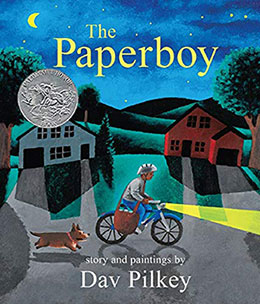
For many children, a bicycle is their first opportunity to explore the world from the driver’s seat of a wheeled vehicle. Indeed, a generation ago, many young entrepreneurs delivered newspapers by bicycle, as in the 1997 Caldecott Honor book The Paperboy, by author-illustrator Dav Pilkey. He was a paper carrier as a youth in Ohio1 and shares that the book was “sort of a meditation or almost a reflection on being a child and being very independent and having a job at the age of 12, and riding your bike through the neighborhood when it’s all quiet. It was a nice vision to explore.”2
The story begins on the title page, as a delivery truck leaves the loading dock of the Morning Star Gazette in the middle of the night. On the following full-bleed double-page spread, Pilkey uses the copyright and dedication pages as a canvas, with the truck traveling along a country road. In the third spread of this sequence, the truck is parked in front of a home while a worker unloads a heavy bundle of newspapers.
From here, the text begins and the focus changes to a boy in bed, dog snoozing at his feet in the early morning darkness. Once awake and dressed, the paperboy and Corgi eat breakfast in a quiet, warm-hued home, before moving to the garage to pack newspapers in a sack. On this spread, readers spy part of a bicycle wheel and fender peeking in from the far recto.
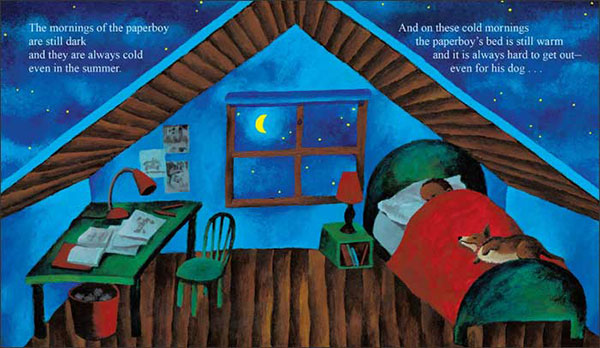
When the two begin their newspaper route, the boy biking with the dog trotting behind him, the moon and stars light the sky. On these expansive spreads, the bicycle lamp guides the paperboy past dark homes in the sprawling small town. In a naïf, child-friendly style, the flat, acrylic and India ink3 illustrations are imbued in blues and greens outdoors, where shadows abound. When the two complete the route under a spectacular orange and rose sky, a few lights appear in homes as “little by little the world around them wakes up.” Subtle changes in color and light show the passage of time. The sun rises in the dazzling sky as the pair make their way back to bed. In lush, cool hues, the final single-page spread shows the boy and dog floating in their dreams in an homage to Marc Chagall.
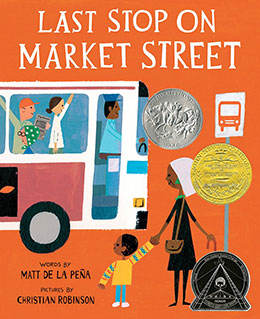 Taking a turn from the rural to the urban, two Caldecott Honor books feature city buses. In Last Stop on Market Street, written by Matt de la Peña and illustrated by Christian Robinson, a boy and his grandmother leave church on a Sunday morning and climb aboard a bus. The trip appears to be routine for the pair, although CJ expresses some reluctance. Nana, however, remains upbeat and encouraging. Rather than look out the bus windows to watch the cityscape, CJ and Nana observe the intriguing passengers. The interior of the bus is a dull green and the rich colors of its passengers are generally muted.
Taking a turn from the rural to the urban, two Caldecott Honor books feature city buses. In Last Stop on Market Street, written by Matt de la Peña and illustrated by Christian Robinson, a boy and his grandmother leave church on a Sunday morning and climb aboard a bus. The trip appears to be routine for the pair, although CJ expresses some reluctance. Nana, however, remains upbeat and encouraging. Rather than look out the bus windows to watch the cityscape, CJ and Nana observe the intriguing passengers. The interior of the bus is a dull green and the rich colors of its passengers are generally muted.
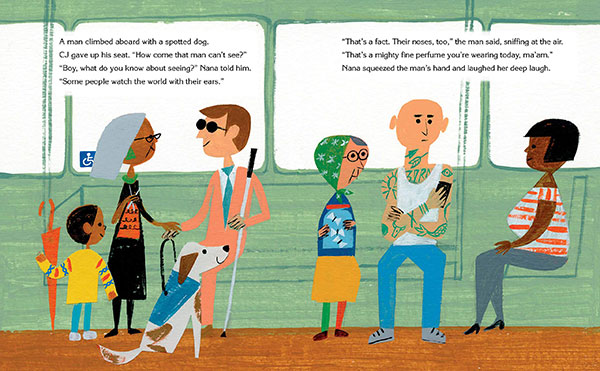
written by Matt de la Peña, G.P. Putnam’s Sons, 2015
Color bursts from a double-page spread when one of those riders begins playing his guitar and CJ is “lost in the sound [giving] him the feeling of magic.” The palette changes once again to subdued tones as the Nana and the boy disembark at the last bus stop and walk to their destination. She reminds her grandson of the beauty of the bleak neighborhood as they arrive to volunteer at the soup kitchen, welcomed by familiar faces.
Robinson created his cartoonlike illustrations with acrylic paint and collage, using some digital manipulation. From smaller vignettes to framed and unframed single- and double-page spreads, the illustrations reflect a cityscape familiar to many children. Robinson, who grew up riding the bus with the grandmother who raised him, muses, “And I think there’s something healing about seeing yourself, seeing your community shown in a book. …[It] was so important for me to show the city as it feels, as I experience it.”4 For young readers who have never ridden a bus, the book brings to light a dynamic environment where one can “always [find] beautiful.”
The genesis of the book broke protocol, as Robinson explains: “So when illustrating a book, it generally begins with the words that the author writes. In this case, Last Stop on Market Street kind of began with a painting that I did of a boy and his grandmother riding a bus. And then Matt saw that picture and an entire story kind of came from that.”5 The distinguished work brought Robinson a 2016 Caldecott Honor and de la Peña a Newbery Medal.
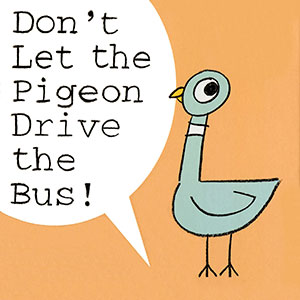 In a departure from this heartfelt story, author-illustrator Mo Willem’s Don’t Let the Pigeon Drive the Bus! is an interactive romp involving an empty bus and a pigeon who is determined to drive it, as suggested on the front endpapers. However, in the opening pages of this postmodern picture book, the bus driver announces that he needs to leave for a little while, asking readers to “watch things” until he returns. His last emphatic request conveniently appears on the title page: “Don’t Let the Pigeon Drive the Bus!”
In a departure from this heartfelt story, author-illustrator Mo Willem’s Don’t Let the Pigeon Drive the Bus! is an interactive romp involving an empty bus and a pigeon who is determined to drive it, as suggested on the front endpapers. However, in the opening pages of this postmodern picture book, the bus driver announces that he needs to leave for a little while, asking readers to “watch things” until he returns. His last emphatic request conveniently appears on the title page: “Don’t Let the Pigeon Drive the Bus!”
Not surprisingly, Pigeon peeks in from the recto of the dedication page while the driver saunters off the verso on the copyright page. Pigeon officially makes his entrance in the following spread, the bus parked in the background. In a series of single-page spreads, Pigeon appeals directly to readers with persuasive, albeit unreasonable, reasons why he should drive the vehicle. Pigeon continues his pleas in a double-page spread of eight vignettes. A page turn shows the exasperated bird’s dramatic breakdown. In the next spread, a sulking Pigeon walks off.
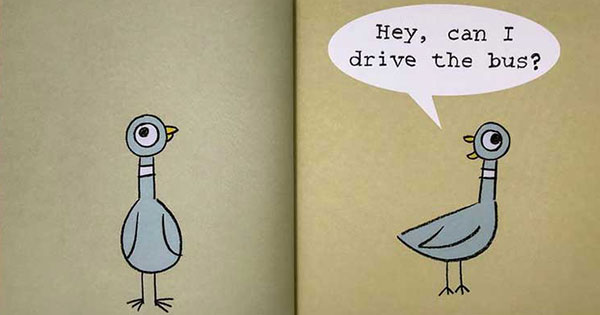
The return of the grateful bus driver doesn’t mean the end of the story. Endpapers of a dreaming Pigeon suggest that he has other goals to pursue, perhaps behind the wheel of a semi-truck.
Willems created the calligraphic cartoon drawings in dark marking pencil and then digitally cleaned and colored the images. With simple lines and limited colors, Willems conveys a remarkably expressive Pigeon. The illustrator explains, “I like my characters to be two-dimensional. Just because you can do something in 3‑D doesn’t make it better. I want my line to be focused, so the emotions of a character are clear.”6 Unabashed simplicity and clarity beget brilliance in this 2004 Caldecott Honor book.
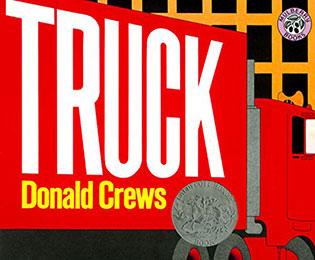 In Donald Crews’s 1981 Caldecott Honor book Truck, the protagonist shifts from driver or passenger to the vehicle itself. A red semi-truck, with “TRUCKING” emblazoned in white block letters on its side, departs a city with a load of tricycles. The truck crosses an expansive landscape during the day and at night, in clear, rainy, and foggy weather, until it reaches another urban warehouse.
In Donald Crews’s 1981 Caldecott Honor book Truck, the protagonist shifts from driver or passenger to the vehicle itself. A red semi-truck, with “TRUCKING” emblazoned in white block letters on its side, departs a city with a load of tricycles. The truck crosses an expansive landscape during the day and at night, in clear, rainy, and foggy weather, until it reaches another urban warehouse.
There is no textual narrative, yet this is not a wordless book. Words appear on every double-page spread, always on the iconic red truck, and often on road signs and other vehicles. Diagonal lines convey movement and momentum within the illustrations. Crews’s contemporary, energetic illustrations meld such styles as Pop art and constructivism.7 His use of graphic imagery is influenced by his background as a designer. Crews reflects, “So, being a designer and being a communicator, pictures came naturally, because telling stories and explaining things is what designers do. It’s the same thing with a picture book. You’re telling a story, primarily in pictures, with some words as support….The fact that they call it literature is an extension I didn’t intend.”8 Design takes center stage in the book, even in its trim size: The open book is the same oblong shape as a truck trailer.
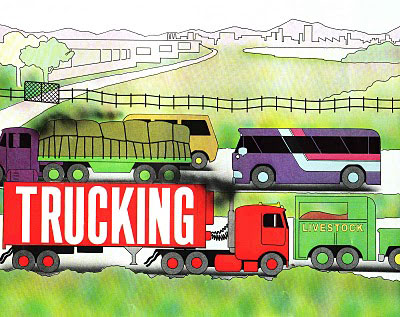
from Truck, Greenwillow Books, 1980
The bright primary and secondary colors of the flat, poster-like9 illustrations were created from four halftone separations with black line drawings.10 The artwork focuses on buildings and vehicles, roads and countryside. No pedestrians are shown, nor are any drivers seen through the black windshields. Crews allows the reader to complete the narrative. Who is driving the bus? Where is its final destination? How long is the journey? Finally, one tricycle box remains on the truck. Was it overlooked or is it intended for a special child?
Through a range of Caldecott Award books, readers take road trips by bike, bus, or truck. Delving into these picture books puts readers in the driver’s (or passenger’s) seat as they expand their experiences. In Part 2, readers will take picture book journeys by train.
Picture Books Cited
Crews, Donald. (1980). Truck. Greenwillow.
de la Peña, Matt. Last Stop on Market Street. (2015). Illustrated by Christian Robinson. Putnam.
Pilkey, Dav. (1996). The Paperboy. Orchard.
Willems, Mo. Don’t Let the Pigeon Drive the Bus! (2003). Hyperion Books for Children.
Notes
- Alexie Basil, “5 Fascinating Facts about Dav Pilkey and The Paperboy,” Judy Newman at Scholastic, accessed 6 January 2022.
- “Transcript from an Interview with Dav Pilkey,” Reading Rockets, accessed 6 January 2022,.
- Association for Library Service to Children (ALSC), The Newbery & Caldecott Awards: A Guide to the Medal and Honor Books (Chicago: American Library Association, 2017), 112.
- “Interview with Matt de la Peña and Christian Robinson,” Scholastic Book Clubs, accessed 6 January 2022.
- “Interview with Matt de la Peña and Christian Robinson.”
- Lisa Kumar, ed., “Mo Willems (1968 – ),” Something about the Author 228 (Detroit: Gale, 2011), 208.
- George Bodmer, “Donald Crews: The Signs and Times of an American Childhood — Essay and Interview,” African American Review 32, no. 1 (Spring 1998).
- George Bodmer, “Donald Crews.”
- George Bodmer, “Donald Crews.”
- ALSC, The Newbery & Caldecott Awards, 125.
References
Association for Library Service to Children (ALSC). The Newbery & Caldecott Awards: A Guide to the Medal and Honor Books. Chicago: American Library Association, 2017.
Basil, Alexie. “5 Fascinating Facts about Dav Pilkey and The Paperboy.” Judy Newman at Scholastic. Accessed 6 January 2022.
Bodmer, George. “Donald Crews: The Signs and Times of an American Childhood — Essay and Interview.” African American Review 32, no. 1 (Spring 1998): 107 – 17.
“Interview with Matt de la Peña and Christian Robinson.” Scholastic Book Clubs. Accessed 6 January 2022.
Lisa Kumar, Lisa, ed. “Mo Willems (1968 – ).” Something about the Author 228 (Detroit: Gale, 2011): 203 – 10.
“Transcript from an Interview with Dav Pilkey.” Reading Rockets. Accessed 6 January 2022.
